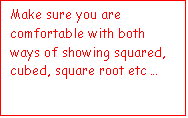 Eg: Force in Newtons express this in base
units:
Eg: Force in Newtons express this in base
units:All physical quantities consist of a numerical magnitude
and a unit and can be expressed in terms of the SI base units:
The base units are:
Derived units:
All units can be derived from products of the base units
its just simple algebra:
 Eg: Force in Newtons express this in base
units:
Eg: Force in Newtons express this in base
units:
F= ma = kg
x m/s2
Newton = kilogramme metre per second squared
Often shown as:
kgm/s2 OR
kgms-2
Q1:
Derive the following into correct base units:
a) speed
b) acceleration c) pressure
d) kinetic energy
e) potential energy f) voltage
g) resistance
h) friction
Q2: Prove by deriving into correct base units that the following equations are dimensionally correct:
a)
Energy =
mass x speed of light squared
b)
Acceleration
due to gravity = Weight in Newtons
(in ms-2
)
Mass in
kilogrammes
Very big and very small numbers can be shown like this
| Take a careful note between the capital letters and the lower case it makes a difference ask if uncertain |
· pico (p) 10-12
·
micro (m)10-6
·
milli
(m)10-3
·
centi (c)
10-2
·
deci (d)
10-1
·
kilo (k)
103
·
mega (M)
106
· giga (G) 109
·
tera (T)
1012
Eg: 1 km = 1 x 103m = 1000metres
Q3: Write the following out in full:
a) 10kJ b)
2.56kV c)
10cm d)
100 mg
e) 5 MJ
f) 1.234 TW
g) 4.56 nK
Q4:
convert the following to the nearest power of ten symbol:
a)
10000m b) 0.00004 A
c) 1.2 x 107 C